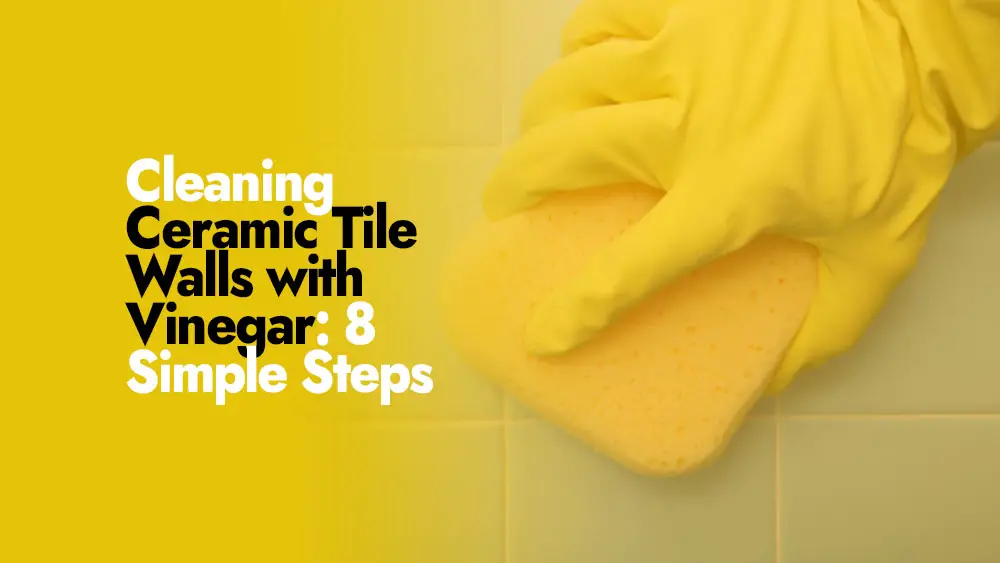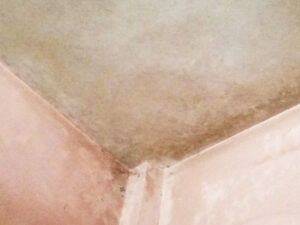Ceramic tile walls are perfect for kitchens, bathrooms, and other wet environments in the house. However, over time they may become stained, dirty, or discolored which makes the room less appealing. There are cleaning products on the market which claim to repair ceramic tiles. However, many contain harmful chemicals which could affect both your environment and health.
Vinegar can be an easy and efficient way to clean walls made of clay tiles. As a natural cleaning product that’s safe, cheap, and readily available in most households. Vinegar has long been used as an efficient means for cleansing surfaces, including bathroom walls made of ceramic tile.
In this blog post, we’ll show you the benefits of using vinegar to clean ceramic tile walls, as well as steps and tips that will ensure optimal results. Vinegar can provide an effective and safe means of cleansing kitchen backsplashes, bathroom tiles or wall ceramics.
Steps to Clean Ceramic Tile Walls With Vinegar
Vinegar is a safe, natural way to restore the shine and beauty of ceramic tile walls with vinegar cleaning. Here’s a step-by-step guide on how you can use vinegar as an efficient cleaning product for ceramic tiles on walls.

Step 1: Assemble Your Items
Before using vinegar to clean ceramic tile walls, the necessary equipment must first be secured. These include:
Spray bottle filled with white vinegar and water. Utilize a cloth, microfiber cloth, or sponge for cleaning purposes.
Step 2: Combine vinegar with water
Vinegar is an extremely potent cleaner that may be too powerful for use alone, so for optimal use on ceramic tile walls. You will need to mix it with water in an equal ratio based on how dirty and stained your ceramic tiles are. One part vinegar to two parts water should get rid of light spots. Otherwise, try mixing equal parts of vinegar and water instead.
Step 3: Check for small spots
Before undertaking a large wall of ceramic tiles, it is wise to conduct a test area first. Make sure the vinegar solution does not cause damage or alter its colors. Place some vinegar solution behind a toilet or under a sink where it won’t be seen, and allow it to set for several minutes. Then wipe it off with a cotton cloth or sponge. Next, check for signs of staining and other damage before continuing your task of cleaning the remaining wall area.
Step 4: Make use of the vinegar and water solution
Once you have successfully tested your vinegar solution on a small area of ceramic tile walls and are confident it’s safe, it’s time to apply the solution more broadly. Pour it into a spray bottle and spray the vinegar solution onto various areas of the wall in sections. Use a scrub brush gently if necessary to scrub away dirt or stains before working in small sections, so as not to allow any drying of the solution on the wall surface.
Step 5: Rinse Your Walls
Once you’ve applied vinegar solution to your ceramic tile walls and scrubbed away any dirt or spots. It is time to rinse them with clean water in a bucket filled. Use a microfibre cloth or sponge to wipe away the solution from your walls. Make sure that any leftover vinegar solution has been eliminated by thoroughly rinsing off.
Step 6: Let the walls dry completely
Once you’ve rinsed the walls, it is vitally important that they dry completely so as to avoid water spots or streaks appearing later. Use a dry microfiber cloth or sponge to wipe down and absorb any additional liquid left behind from cleaning, while wiping down with a clean microfiber cloth will also work effectively in this regard.
Step 7: Clean the grout
Most ceramic tile walls feature grout lines between tiles that over time can become dirty and discolored. To effectively clean these lines, mix equal parts vinegar and water in a spray bottle and spray this solution over them. Gently scrub with a scrub brush then rinse them out using clean water to bring back their original color.
Step 8: Prevent the Recurrence of Stains
Preventing ceramic tile walls from becoming stained again requires taking proactive steps. Sealing grout lines is one way of doing so. By sealing these, dirt and stains won’t have the opportunity to enter, making cleaning much simpler. Another effective strategy to keep walls unstained is wiping them down regularly with a wet cloth to eliminate dust build-up on their surfaces.
Clean your ceramic tile walls using gentle solutions such as vinegar and water for the best results. Harsh cleaners could cause irreparable harm to tiles or grout, stain or etch surfaces, and damage surfaces altogether. To keep them looking their best, mild cleaning solutions like vinegar should be utilized instead.
How much vinegar do I need to clean the walls of clay tiles?
The amount of vinegar required for cleaning ceramic tile walls depends on several factors, including the size of the area you are cleaning as well as any dirt or grime buildup. An effective cleaning mixture combining one part vinegar with one part water should provide sufficient cleaning power without harming ceramic tile walls.
But if your ceramic tile walls are particularly stained or dirty, a more aggressive solution might be necessary. One effective option would be using more vinegar and less water, two parts vinegar to one part water may work best here. But be mindful that more potency might increase the chance of tile or grout damage. So it’s wise to test any solution in an inconspicuous area first before proceeding with cleaning the whole wall.
If your goal is simply keeping the ceramic tile walls sanitary, a milder option such as one part vinegar to two parts water may be more suitable.
At the end of the day, how much vinegar you use depends entirely on your own personal preferences and the degree of dirt on your ceramic tile walls. Just be careful that any too-strong solution does not damage either tiles or grout in any way.
Can apple cider vinegar be used as an effective wall cleaner instead of white vinegar?
Yes, apple cider vinegar can be an effective solution for cleaning ceramic tile walls instead of white vinegar. Being acidic like white vinegar does, apple cider vinegar works to remove dirt, grime, and spots while keeping ceramic tiles looking their best.
Apple cider vinegar might differ in both color and aroma from white vinegar, potentially altering how your ceramic tile walls appear and smell. Furthermore, apple cider vinegar might be more costly. Therefore it might not be the ideal solution if your goal is to save money when cleaning ceramic tile walls.
If you wish to use apple cider vinegar on ceramic tile walls, be sure to mix it with water beforehand. A one-to-one ratio would work nicely but feel free to experiment depending on how dirty your walls may be.
Typically, ceramic tile walls can be cleaned using either white vinegar or apple cider vinegar, your preference will depend on what works for you! Make sure that both options are diluted before applying them directly on a wall. Test on an inconspicuous spot first to make sure there’s no lasting damage!
Can vinegar be used to clean glossy ceramic tiles?
Yes, vinegar can help clean ceramic tiles with a polished finish. Due to its acidic nature, vinegar will dislodge dirt, grime, and spots from ceramic tiles even those glazed over.
But it is important to remember that some glazed ceramic tiles may be more sensitive than others to acidic solutions like vinegar. If too strong a solution or too long a soak occurs, its excessive exposure could damage or alter its glaze, potentially altering its color or altering it altogether.
To use vinegar to clean glazed ceramic floors, mix equal parts vinegar and water in a spray bottle or bucket and combine. One part vinegar per one part water should work effectively. However, you may wish to adjust this ratio depending on how dirty your tiles are.
Apply the vinegar solution using a sponge or cloth, working on small sections at a time until all areas have been thoroughly covered. Take care not to let too much time pass before taking action as prolonged contact could damage the glaze.
At this stage, carefully rinse the tiles with clean water to remove any vinegar solution left behind and dry them with a clean towel or cloth.
Vinegar can be an efficient and safe way to clean ceramic tiles if you use enough and do not leave it on for too long.
Are colored marble tiles safe to be cleaned with vinegar?
Yes, vinegar can often be safely used to clean colored ceramic tiles provided that the proper amount is used and that too much scrubbing force is not applied. But there are certain factors you need to keep in mind if you don’t want your tiles broken, or their colors altered by using too much acidic cleaner.
Before applying the vinegar solution to an entire surface of colored ceramic tiles. It’s wise to test a small, inconspicuous area first to ascertain whether the vinegar solution will damage or alter its hue. Doing this will allow you to determine whether using too much will cause irreparable harm or alter its hue.
Second, make sure that the vinegar solution is properly mixed so as to not damage or stain tiles with their strength. A mixture of one part vinegar and one part water works well as an effective combination, but you may need to modify this according to how much dirt and grime is on the tiles.
Thirdly, avoid using hard brushes and scrubbers that could scratch or mar the surfaces of the colored tiles. Instead, opt for using soft sponges or cloths for floor scrubbing.
Once the vinegar solution has dried on your tiles, be sure to thoroughly rinse and dry them off using a clean towel or cloth.
Overall, vinegar can be an efficient and safe way to clean colored ceramic tiles. Provided that proper precautions are taken and enough vinegar is diluted appropriately.
Can I use a vinegar solution to clean between my ceramic tiles?
Yes, vinegar solutions can help clean the gaps between ceramic tiles. Due to being acidic, vinegar can easily dislodge dirt, grime, and spots from grout lines – leaving them looking fresh and bright again!
Pour vinegar can help clean gaps between ceramic tiles by mixing equal parts white vinegar, and water in a spray bottle or bucket and stirring vigorously. You may wish to enhance its cleaning power further by including dish soap or baking soda in the solution.
Next, pour the vinegar solution directly onto the grout lines until all of it has become saturated with moisture. Let it sit there for five to ten minutes so the vinegar can break down dirt and grime build up on its own.
Scrub the grout lines gently using a brush with stiff bristles or an old toothbrush, taking care to work on small sections at a time. Make sure that you frequently rinse your toothbrush or brush in order to eliminate any dirt or grime that has been collected in it from the grout lines.
Finally, rinse the grout lines thoroughly with clean water to get rid of any remaining vinegar solution, and dry them using a clean towel or cloth.
Overall, vinegar can be an effective and safe solution for cleaning ceramic tile grout gaps. However, for very dirty or stained grout you may require stronger cleaners or professional assistance.
How often should I use vinegar to clean the tiles on my walls?
How frequently you should use vinegar to clean ceramic tile walls depends on several factors. Including their frequency of use and amount of dirt build-up. As a general guideline, however, if you want your ceramic tiles to appear spotlessly clean at all times, then at least once a month should be enough for thorough vinegar cleaning of them.
However, if your tile walls are located in an area with heavy foot traffic or are used frequently by pets or children, extra frequent cleanings may be required to keep up with dirt and grime that builds up over time. Furthermore, frequent cooking or bathroom usage necessitates additional tile wall cleanings in order to prevent grease build-up, or soap scum formation on ceramic tile walls.
As an overall guideline for when to use vinegar on ceramic tile walls, look at how much dirt and grime has built up on them. If they appear dull, stained, or damaged then perhaps now is the time for an intensive vinegar cleaning regimen, or set a schedule so your tiles always look their best!
Final Thoughts
Vinegar can be an economical, effortless, and effective solution to keeping ceramic tile walls looking their best. By following the steps outlined here, vinegar will safely and easily clean away dirt, grime, and stains on its surface – leaving it looking as good as new!
Notable points from this guide include properly diluting vinegar, being gentle with tiles to avoid damage, and testing any solutions on small, hidden parts before applying them all over.
We analyzed some of the most frequently asked questions about cleaning ceramic tile walls with vinegar, such as whether it can be safely used on colored or polished tiles, and whether it can be used to cleanse between tiles.
Overall, using vinegar to clean ceramic tile walls is an easy and cost-effective way to keep them looking their best for years. By including it as part of your regular cleaning regimen, this solution can keep them looking their best!







